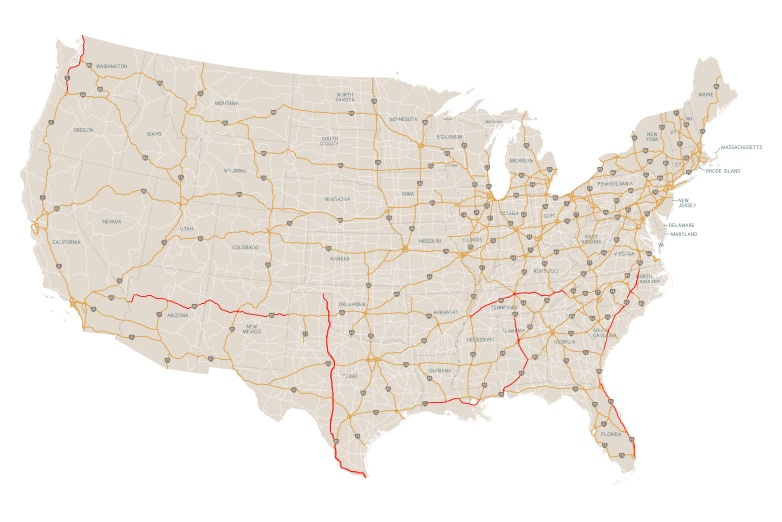
We drive them every day, but some highways are safer than others. Whether it’s because of a high speed limit, the volume of cars traveling it, or the condition of the road itself, some highways consistently have more crashes than others.
To find out just how dangerous our highways are, the vehicle data management company Geotab calculated what it calls a “fatal crash rate” for all the highways in the United States.
By analyzing data from the National Highway Traffic Safety Administration and factoring in the average traffic flow using information from the Federal Highway Administration, Geotab was able to identify where the dangerous and most deadly traffic patterns were found.
The Most Dangerous Highways in the U.S.
Here’s what they determined to be the ten most dangerous highways in America based on the number of recorded crashes in the past ten years:
1. US-1, Florida. Not only has this part of US-1 had the most crashes by far of any highway, with 1,011 crashes reported, it also has the highest rate of fatalities: 1,079.
2. I-40, Tennessee. Connecting the state’s three largest cities, I-40 had 427 crashes and 517 deaths.
3. I-40, New Mexico. As the connecting byway between Arizona and Texas, this well-traveled stretch of highway had 344 crashes and 395 fatalities.
4. I-65, Alabama. Also known as “Heroes Highway,” I-65 had 336 crashes and averages 34 fatalities a year.
5. I-90, Louisiana. Although I-90 averages 27 fatal crashes every year, its best-known tragedy was actress Jayne Mansfield, who was killed on this highway in 1967. In the past decade, it has had 271 crashes and 295 fatalities.
6. US-83, Texas. Running from the Texas/Oklahoma border all the way south to Brownsville, the longest highway in Texas has had 268 crashes in the past decade and has averaged 26 fatalities a year during that time.
7. I-40, Arizona. This highway replaced most of the famous Route 66 when it opened. I-40 has seen 249 crashes and 293 fatalities in the last ten years.
8. I-95, South Carolina. Running parallel to the state’s Atlantic Coast, this highway was the site of 244 crashes and 301 fatalities.
9. I-5, Washington. The busiest highway in Washington state is also the most dangerous, with 245 crashes and 258 deaths.
10. I-95, North Carolina. Parts of this road include the Dick Fleming Freeway, and it runs from South Carolina to Virginia. It has had 201 crashes in the past decade.
How to Make Dangerous Roads Safer
Being aware of dangerous roads is the first step in making them safer. Every driver plays an essential role in maintaining the safety of our highways, and learning to practice safe driving principles behind the wheel — every time — is each person’s responsibility.
While certain roads are labeled more dangerous than others, the fact is, about 90% of crashes are due to human error. Here are five ways to make highway driving safer, regardless of what road you’re on.
No. 1: Don’t Drive Drowsy
Drivers who are missing sleep are four times more likely to have a car crash than those who get seven or more hours a night. While losing a few hours of sleep may seem harmless, a closer look at statistics shows a direct link between less shut-eye and more crashes.
The effects of drowsy driving can be deadly. If you’re getting sleepy behind the wheel, park and take a nap, drink some water, walk around — whatever it takes to make you safe enough to get back behind the wheel.
No. 2: Lose the Distractions
While it’s a well-known fact that drinking and driving is a dangerous practice, many drivers don’t realize that distracted driving can be just as dangerous. Whether taking or making a phone call, texting, glancing at the GPS, talking to another person in the vehicle, or eating, distractions can quickly become deadly under the wrong circumstances.
No. 3: Keep Your Distance
About 30% of crashes are rear-end collisions, and the easiest way to prevent them is to avoid tailgating. Maintaining proper following distance between you and the vehicle in front of you means that you’ll have time to react in any driving environment.
When you follow a car too closely, two things happen: you’re focusing on the vehicle rather than looking at what’s going on around you on the road, and you’re not giving your vehicle enough time to stop if the driver slams on the brakes. Both scenarios can have deadly consequences.
No. 4: Buckle Up
In cases where you can’t avoid a crash, you can at least minimize the damage by taking the proper safety precautions. According to the Centers for Disease Control and Prevention, one of the most effective ways to keep yourself safe in a crash is to wear a seatbelt.
No. 5: Don’t Forget Your Keys
Implementing The Smith5Keys® principles can provide you with the proper tools for safer driving practices every time you get behind the wheel. The 5Keys way of driving can be applied to any vehicle, with any driver, on any road.










